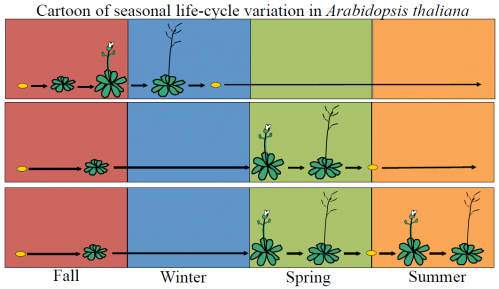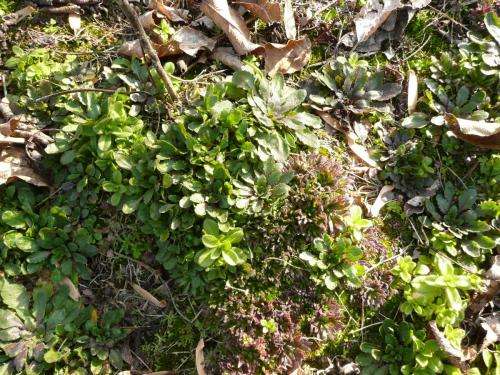Seeds out of season: New modeling framework elucidates the interaction between various life stages of a plant

Researchers have created a model that considers how different stages of a plant's life cycle interact with each other. Whereas previous studies have examined the seed, vegetative, and reproductive phases individually, scientists in a working group funded by the National Evolutionary Synthesis Center (NESCent) sought to understand the relationship between the stages in reaction to environmental and genetic factors.
"Most research is focused on understanding each of those processes independently," says lead author and Duke University graduate scholar Liana Burghardt. "We're creating a framework to understand how they relate to each other."
The findings suggest that when environmental factors alter the timing of one stage of a plant's life cycle, the duration of subsequent stages also adjusts. Climate change has affected growing season lengths worldwide, and a better understanding of the factors that influence life stages as a whole could prove especially insightful. The paper will appear in the February issue of The American Naturalist and is now available online.
"A lot of organisms are very flexible in their responses to the environment," Burghardt says. "The way these traits relate to each other in seasonal environments might be very general, but the exact details will depend on the timing systems that have evolved in each organism."
To consider both environmental and genetic factors in tandem, Burghardt and her coauthors simulated life cycles in four distinct locations within the range of the weedy plant, Arabidopsis thaliana. A. thaliana often follows the classic winter annual life cycle in which seeds sprout in the fall and flower in the spring, but it can also germinate and flower in other seasons by prolonging various life stages. This ability makes it an ideal species for studying the interaction between life-cycle stages.
The researchers also manipulated genetic factors, namely seed dormancy and floral repression and found that higher levels of these traits delay germination and flowering, respectively.

"Germination traits really had a larger effect than flowering traits on what life cycle is observed and whether you see multiple generations in a year," Burghardt says. "Multiple generations could be very advantageous in some environments because you could get in more reproductive phases."
Although floral repression had less of an impact on the number of generations completed, the trait could target flowering to occur at specific times within a growing season. Previous studies found that germination varies across the range of A. thaliana with more delayed germination in the south of the range and quicker germination in the north. The researchers discovered that these genetic patterns led to a consistent annual life cycle across A. thaliana's geographic range.
Burghardt compares the way a plant adjusts its life cycle to how an employee manages her time within a workday: One task must be completed before another begins, and the time expended on a single item will affect all subsequent tasks. Just as an employee strives to finish her duties within an eight-hour workday amid shifting priorities and unexpected challenges, A. thaliana has evolved to maintain a year-long life cycle despite changes in the environment.
"The next big step is to incorporate survival and offspring production into the model." Burghardt says. "Right now we're just modeling when plants are going to be doing what, but the ultimate question is how those predicted life cycles relate to fitness. If a seed germinates at the wrong time of year, and the environment gets really dry then it could die without reproducing."
With additional information, this modeling framework could have meaningful implications beyond this one species. A stronger understanding of plant life cycles has the potential to improve crop yields and conservation efforts amid a changing climate.
More information: Burghardt, Liana T. et al. "Modeling the influence of genetic and environmental variation on the expression of plant life cycles across landscapes." The American Naturalist. www.amnat.org/an/newpapers/FebBurghardt.html
Journal information: American Naturalist
Provided by National Evolutionary Synthesis Center (NESCent)




















